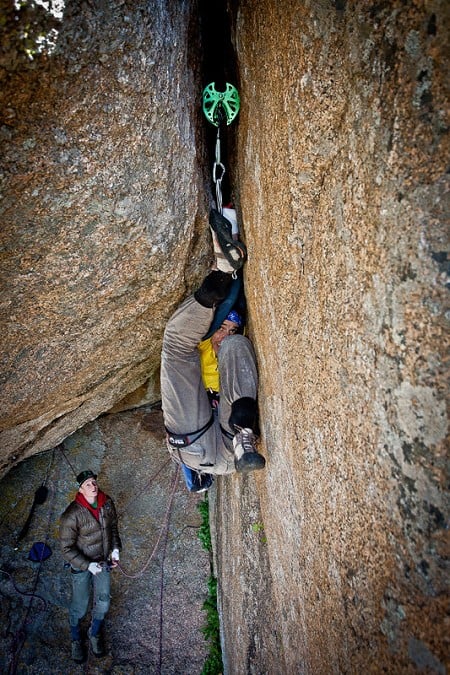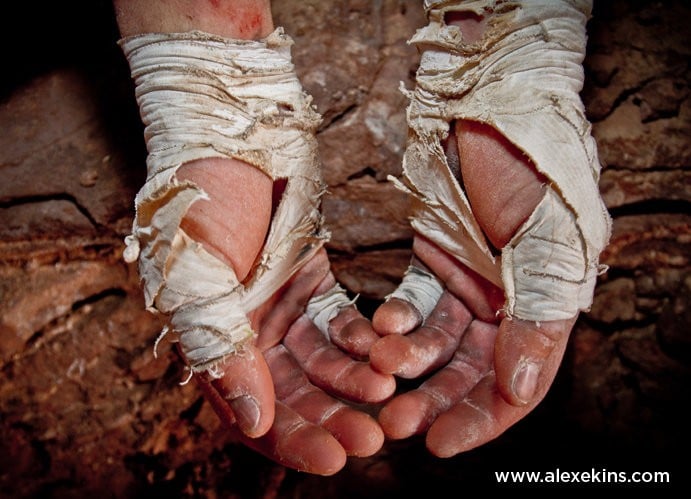Part 4 - Offwidth Cracks
Offwidthing
Offwidths are the daddy of all cracks. The brilliant 3D nature of these cracks along with the physical factor brings about a hugely satisfying (if tiring!) form of climbing, for those out there that are dedicated enough to learn this technique. All of us have been through at least one emotional experience on this size of crack, but I can promise you that it doesn't always have to be this way if you can nail some of the fundamental techniques.
Offwidths are typically known as the cracks that are bigger than your fist, but smaller than your whole body. This results in you being unable to use conventional jams (finger/hand/fist jams) or able to chimney inside of the crack. Obviously this means that offwidths are relative to body size, so don't worry if someone else's fist crack is your offwidth – aim to be flexible and bring out the new techniques you hopefully learn in this video.
Like all forms of crack climbing, there are some tricks of the trade and in this case, there is a whole bag of them! You should take into account your gear, clothing, feet, hands and general body conditioning – even on the lower grades. If can't emphasise enough, how much a small mistake in something like clothing will cost you on a route of this size.
Clothing
A lot of people underestimate this factor. The masters of crack climbing from the 60s and 70s knew that a good thick woolly jumper or jeans would pay dividends once a shoulder or knee was inserted. Nowadays though, everyone seems to have gone down the route of shiny technical fabrics which are brilliant at drying and breathing, but terrible in wide cracks! Ditch the hi-tech and go old school I'm afraid. Corduroys, jeans, fleeces and cotton are the way forward.

Upper body
There are 3 main techniques to use for the top portion of your body; hand stacking, arm bars and chicken wings. Hand stacking is really the reserve of advanced offwidth climbing and to be honest, you'll only find this of real use once you climb routes of E3 and above. On the other hand, arm bars and chicken wings are absolutely brilliant – learn to use these well and you'll thank yourself.
Aside from watching the video in this episode you should remember a few key pointers:
Arm Bars: the elbow should press hard into the side of the crack; if it's not slightly painful, then you're not doing it quite right. Try to keep the arm bar at below shoulder level – the common mistake is to try and use it too high, where you'll find it absolutely no use. The arm bar should mainly be considered a tool to "push" you up the crack, so keep it low and getting pushing!
Chicken Wings: this technique is mainly used as a resting aid. Your tightly bent arm produces an extremely effective camming device, which should be relied on to rest and place gear. It can be used to make upward progress in cracks, but try to learn to use the arm bar first, before falling back on this technique.
Lower body
The most important thing I learned in offwidthing, by far, was the action of the outside foot. The use of this limb is like the Holy Grail of this width and if you get it right, the grades will feel soft and you'll cruise route after route. In almost every instance (apart from steep offwidths) you want to aim to jam your outside foot in a "heel-toe" position across the crack. Once jammed (it can feel very tenuous to start) thrust hard off this foot and you'll find yourself propelled upwards reassuringly fast. As soon as your have straightened that leg, try to place it as high as possible again and repeat this process. If an offwidth feels hard or you think you can go no further, it's almost certainly because of your outside foot. Never forget it!
I'm often asked what you do with the inside leg/foot - the answer is actually slightly ambiguous (as it's more of an intuitive movement). You can either use a heel-toe inside, or even press the inside of your knee against the side of the crack to gain a small amount of purchase. As you can imagine, this leg is buried quite deep into the crack and takes very little of your body weight, so keep reminding yourself that this leg is of less importance and keep thinking about that outside foot! Have I said that enough?!
Anything else I should know?
It's a bit beyond the level of basic offwidthing, but it's well worth experimenting with a technique called Leavittation. There's some basic info that you can find on google, which describes the method and even the madness.
Definitely aim to wear a pair of stiff-soled boots when climbing offwidths. If you're really keen, you might even want to think about a pair of hi-tops that will protect your ankles.
The techniques required to climb offwidths have definitely taken me the longest to perfect, so be prepared to spend some significant time learning the craft. It's not a simple one to become good at, but it will reward you in the long run.
Don't forget that outside foot!
Classic offwidth cracks /routes with crucial offwidth sections

